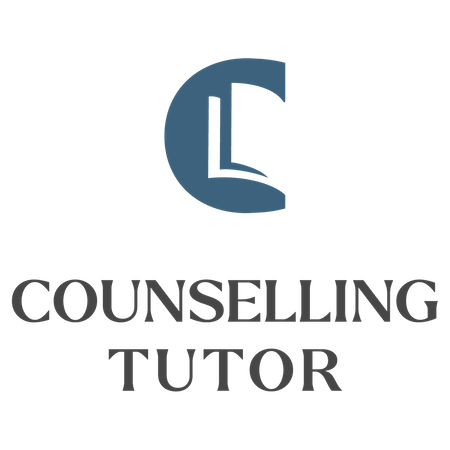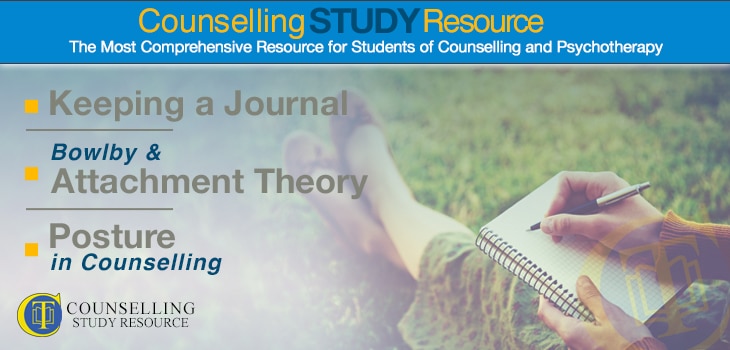027 – Keeping a Journal – Bowlby and Attachment Theory – Posture in Counselling
In episode 27 of the Counselling Tutor Podcast, Rory Lees-Oakes and Ken Kelly discuss the benefits of keeping a journal and how to do so. ‘Theory with Rory’ looks at John Bowlby’s work on attachment. Finally, the presenters discuss posture in counselling.
Keeping a Journal
On counselling courses, we are encouraged to keep a journal. We may feel resistant to this idea to start with, and wonder what we will find to write about, but there are many benefits, including providing:
- a record of our progress, which we can look back on
- useful material to draw on when writing self-awareness assignments
- practice in naming feelings – not just the ‘primary colours’ of the main emotions (anger, sadness, happiness etc.) but all their ‘subtle shades’, so enhancing your ability to use a wide range of emotion words in client work
- an opportunity to identify ‘edge-of-awareness’ issues to explore further, including in personal counselling.
The idea of starting a journal may seem daunting, especially for people who may not be naturally keen on writing, e.g. people with dyslexia. Ken and Rory offer tips on overcoming this reticence:
- Just make a start, writing about whatever comes to mind – it probably seems harder in prospect than when you get going.
- Try to set aside some quiet time each day to write in your journal.
- Don’t worry about neatness or spelling – after all, it’s only you who has to read it!
- If you really can’t face writing, try audio-recording your thoughts and feelings instead. Hearing the tone of what you’re saying can even help to reveal your emotions.
Bowlby and Attachment Theory
John Bowlby’s attachment theory portrays a universal truth – common to all modalities – that the experiences of childhood feed into the people we become. Attachment theory came into its own in the 1950s, with the most recent breakthrough happening as recently as the late 1980s, when Mary Main, together with Judith Solomon, introduced a new infant-attachment classification: ‘disorganized/disoriented’.
Born in London in 1907 – the fourth of six children of physician Sir Antony Alfred Bowlby and Mary Bridget Mostyn – John Bowlby was brought up by a nanny and nursemaids, seeing his mother only once a day. When he was ten years old, he was sent away to boarding school. It may be these personal experiences that led him to develop an interest in developmental psychology.
Having qualified as both a doctor and a psychoanalyst, Bowlby took on the role of Deputy Director of the Tavistock Clinic, London (supporting children with emotional and behavioural difficulties), at the end of the Second World War. In 1949, he was commissioned by the World Health Organization to write a report on refugee children separated from their parents. Entitled Maternal Care and Mental Health, this led to widespread changes in how children in institutionalised care were looked after.
Bowlby was later joined by researcher Mary Ainsworth, who developed his ideas in an experiment called ‘the strange situation’. Watching through a one-way mirror, researchers observed the reactions of children in a play room. Having entered the room with their mother, a stranger (one of the researchers) would then enter and the mother would leave (distressing the child). When the mother returned and the stranger left, the way that the child reacted indicated their attachment style.
Rory summarises Bowlby’s ideas as follows:
- Children between the ages of six and 30 months are very likely to form emotional attachments to their care-givers.
- These attachments can be shown in how the children behave towards those who care for them.
- Children seek to be close to their care-givers, especially in times of distress or when they wish to explore the environment.
- Attachment is an important aspect of psychological health, in particular the ability to form and sustain close relationships.
Attachment theory can help us understand why some clients have difficulties in relationships, and can help them untangle themselves from a difficult past to engage in a more positive and emotionally fulfilling future.
Rory has provided a free download of an attachment style questionnaire, an exercise designed to stimulate self-reflection and discussion among students. To find out more about attachment theory, watch Rory’s detailed lecture on attachment theory here.
Posture in Counselling
Gerard Egan developed the acronym ‘SOLER’ to suggest the best posture in counselling:
- Sit straight.
- Open posture.
- Learn towards the client.
- Eye contact.
- Relax
This is a good starting point, but it is important to true to yourself, developing your own style, and to take account of cultural differences, e.g. in eye contact. Watch what your clients do, and take your lead from them.


